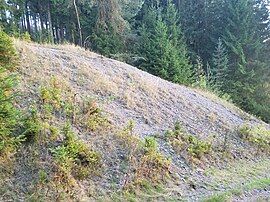Young lion
| Young lion | |||
|---|---|---|---|
| General information about the mine | |||
| Dump of the pit at the middle gallery | |||
| Information about the mining company | |||
| Start of operation | 1780 | ||
| End of operation | around 1890 | ||
| Funded raw materials | |||
| Degradation of | Lead luster , zinc blende , copper pebbles , iron spar | ||
| Geographical location | |||
| Coordinates | 50 ° 47 '42.5 " N , 8 ° 2' 26" E | ||
|
|||
| Location | Salchendorf | ||
| local community | Neunkirchen | ||
| District ( NUTS3 ) | Siegen-Wittgenstein | ||
| country | State of North Rhine-Westphalia | ||
| Country | Germany | ||
| District | Burbach mountain area | ||
Young Lion was a small mine near Neunkirchen - Salchendorf in the southern Siegerland .
The pit was in the local area of Salchendorf, a district of Neunkirchen in the Siegen-Wittgenstein district . It was located in the left Wildebach valley between Salchendorf and Wilden on the northern slope of the Leyenkopf , a mountain in the ridge of the Rassberg .
Aisle means
The middle of the mine was a section of an ore vein over 600 m long, on which the neighboring Ludwigseck mine and the Gleiskaute mine, which was consolidated with the Junge Löwe , were built.
Lead luster , zinc blende , copper pebbles and iron spar were mined . Cobalt nickel pebbles and antimony shine were found occasionally .
history
The young lion pit was first mentioned in 1839. Three tunnels belonged to the pit .
The first deep tunnel was built in the 1850s and belonged to the Gleiskaute mine mentioned in 1780 . This tunnel lies on the valley floor and its mouth hole is still visible today ( location ). Die construction was carried out here from around 1850, and in the 1870s 306 t of galena, 516 t of zinc blende, 141 t of copper ore and 43 t of spate iron stone were mined. The corridor was about 40–50 m long and up to 0.3 m thick and was filled with lead ores, quartz, spate iron, zinc ore and rarely copper pebbles and nickel-antimony luster. Around 1880 the operation on Gleiskaute stopped .
The middle tunnel was below the little train, a former narrow-gauge railway from the Bautenberg mine and has now been filled in. The upper tunnel further up the mountain has now been closed. In 1885, the production consisted of 4 tons of lead ore and 10 tons of zinc blende. The mine was shut down around 1890. The mine field was taken over by Ludwigseck .
In the years 1951/1952, parts of the mine dumps were processed in the flotation plant of the Grube Große Burg .
Restoration of the mouth hole
In 2014 the “Mining and Industry” working group of the Salchendorf Heimatverein opened the mouth of the deep tunnel and designed the area as a vivid mining monument.
See also
literature
- Alfred Henrichs: From Salchendorf's past , Braun printing house, Neunkirchen 1966
- Otto Braun: 700 years Neunkirchen , Neunkirchen 1988
Web links
- Gerd Bäumer: Ore mining in the Siegerland area ( Memento from November 7, 2001 in the Internet Archive )



